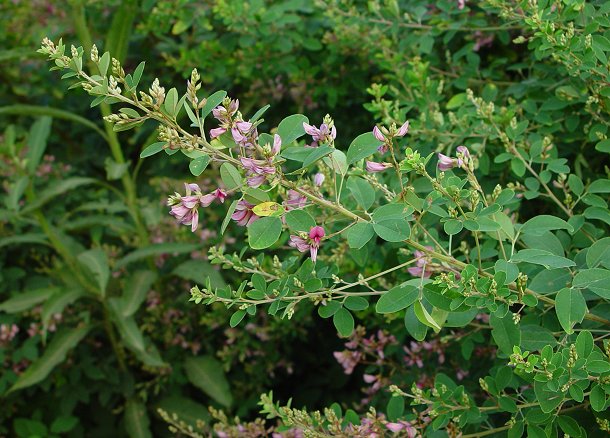Lespedeza bicolor Turcz.
Shrubby Lespedeza

Introduced
CC = *
CW = 5
MOC = 15
© DETenaglia
Lespedeza bicolor Turcz.Shrubby Lespedeza | |
 |
Introduced CC = * CW = 5 MOC = 15 |
© DETenaglia |
|
Family - Fabaceae/Faboideae Habit - Shrub, with multiple stems from a woody caudex. Stems - Erect or arching, to 3 m, 5-20 mm in diameter near the base, extensively branched, densely pubescent with appressed or somewhat spreading hairs, the hairs not confined to longitudinal ridges, nearly glabrous toward the base.
Leaves - Alternate, trifoliate, petiolate. Primary leaves graduating into bracteal leaves, the petiole 10-90 mm long, becoming reduced above, 0.3-1.0 mm wide, glabrous or sparsely hairy. Stipules 2-7 mm long, linear-triangular to nearly hairlike. Leaflets 2-4 cm long, 0.8-2.0 cm wide, 1.5-2.0 times as long as wide, broadly elliptic, rounded at the base, rounded at the tip, occasionally with a mucro and/or a shallow notch at the very tip, the surfaces sparsely to occasionally densely pubescent with appressed hairs, the upper surface sometimes nearly glabrous. Axillary clusters of leaves absent, but side-branching extensive.
Inflorescence - Axillary from the upper leaves, much longer than the subtending leaves, often leafy and branched, forming panicles of racemes. Flowers 12-28 per raceme or more in branched inflorescences, the axis visible between flowers.
Flowers - Papilionaceous. Calyces with the tube 1.5-2.0 mm long, the lobes 2-3 mm long. Corollas 8-12 mm long, dark rose-colored with nearly black areas near the base of the banner, rarely white, the keel much longer than the wings.
Fruits - Modified legumes, those from open flowers 6-10 mm long, the calyx covering the lower 1/4-1/2, those from cleistogamous flowers 6-7 mm long, the calyx covering about 1/4. Seeds 3-4 mm long, dark brown to purplish black.
Flowering - July - October. Habitat - Cultivated fields, waste ground, roadsides. Origin - Native to eastern Asia. Lookalikes - L. thunbergii. Other info. - At present, this shrubby species of Lespedeza is somewhat uncommon in Missouri, recorded from 15 widely scattered counties mostly in the eastern half of the state. Its distribution within the continental U.S. is mainly in the southeast. The plant is easy to identify, being one of only two species of lespedeza in Missouri which are shrubs. The other, L. thunbergii, has narrower leaves and slightly larger flowers. The distinctness of these two taxa in Missouri is somewhat questionable. Most specimens are morphologically close to published species boundaries, and may represent cultivated strains of hybrid origin. The plants have been used for erosion control and are often cultivated as ornamentals. Photographs taken in the Ozark National Scenic Riverways, Shannon County, MO., 7-29-03 (DETenaglia); also at Young Conservation Area, Jefferson County, MO, 8-30-2016 (SRTurner). |